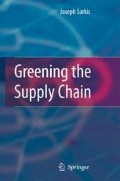Abstract
This paper presents a case study of a supply chain which is concerned with the distribution of aluminium metal, starting from raw material from a Metal Supplier to a Casting Plant, billets from the Casting Plant to the Component Producer, and finally, die-cast components from the Component Producer to the Market. The paper creates a green supply chain by integrating the concerns of transport pollution, marketing costs, time to market, recycling of scrap metal and energy conservation. Simulation and modelling tools are introduced to aid in the decision making process of distance selections and choices of transportation in the case study. Based on a series of user input selections, the simulation results are used to determine a range of optimal plant locations that will balance economical benefits (highest scrap values, least total costs, etc.) as well as environmental stewardship (least pollution).
Access this chapter
Tax calculation will be finalised at checkout
Purchases are for personal use only
Preview
Unable to display preview. Download preview PDF.
References
Ashden Trust (1994). How Vehicle Pollution Affects Our Health. London: Ashden Trust.
Christensen, J. (1999). Seeing a Forest to Save the Trees. New York Times.
Colvile, R.N., Hutchinson, E.J., Mindell, J.S. and Warren, R.F. (2001). The transport sector as a source of air pollution, Atmospheric Environment, 35(9), 1537–65.
Cox, A. (1999). Power, value and supply chain management. International Journal of Supply Chain Management, 4(4), 167–75.
Denton, T. (1998). Sustainable development at the next level. Chemical Market Reporter, 253(7), 3–4.
Flachsbart, P.G. (1999). Human exposure to carbon monoxide from mobile sources. Chemosphere Global Change Science, 1(1–3), 301–29.
Gifford, D. (1997). The value of going green. Harvard Business Review, 75, 11–2.
Hardin, G. (1968). Tragedy of the Commons. Science, 162(1243), 48.
Hibbert, L. (1998). Sustainable activity. Professional Engineering, 11, 32–3.
Hick, S. (2000). Morals maketh the money. Australian CPA, 70, 72–3.
Khoo, H.H., Spedding, T.A., Tobin, L., Taplin, D. (2001). Integrated Simulation and Modeling Approach To Decision Making and Environmental Protection. Environment, Development and Sustainability, 3(2), 93–108.
Matthias, R. (1999). Strategies for promoting a sustainable industrial ecology, Environmental Science & Technology, 33(13), 280–82.
Melnyk, S. and Handfield, R. (1996). Greenspeak. Purchasing Today, July, 32–6.
Miller, W. H. (1998). Citizenship: a competitive asset, Industry Week, 247(15), 104–8.
Ottman, J. A. (1999). How to develop really new, new products. Marketing News 33(3), 5–7.
ProcessModel (2000) Software & Services(ProcessModel, Inc.).
QEPA (Queensland Environmental Protection Agency) (1999). Sustainable Queensland, www.epa.qld.gov.au.
Quinn, B. (2001). Manufacturers squeeze out more energy efficiency. Pollution Engineering, 33(1), 23–4.
Saemann, R. (1992). The environment and the need for new technology: empowerment and ethical values. Columbia Journal of World Business, 27, 186–93.
Shultz II, C.J. and Holbrook, M.B. (1999). Marketing and tragedy of the commons: a synthesis, commentary, and analysis for action. Journal of Public Policy and Marketing, 18(2), 218–29.
Spedding, T.A., Khoo, H.H., Taplin, D. (1999). An integrated simulation approach for teaching industrial ecology. Proceedings of the HKK Conference. Waterloo: Canada.
Stead, J.G. and Stead, E. (2000), Eco-enterprise strategy: standing for sustainability. Journal of Business Ethics, 24(4), 313–29.
Street, A. C. (1986). The Diecasting Book. 2nd Edition, Portcullis Press.
Taplin, D.M.R., Spedding, T.A., Khoo, H.H. (2001). Environmental security: simulation and modelling of Industrial Process Ecology. Paper presented at the Strasbourg Forum, Council of Europe, Strasbourg: France.
US EPA (US Environmental Protection Agency) (2000). Air Pollutants. www.epa.gov.
Author information
Authors and Affiliations
Editor information
Editors and Affiliations
Rights and permissions
Copyright information
© 2006 Springer-Verlag London Limited
About this chapter
Cite this chapter
Hui, K.H., Spedding, T.A., Bainbridge, I., Taplin, D.M.R. (2006). Creating A Green Supply Chain: A Simulation and Modeling Approach. In: Sarkis, J. (eds) Greening the Supply Chain. Springer, London . https://doi.org/10.1007/1-84628-299-3_19
Download citation
DOI: https://doi.org/10.1007/1-84628-299-3_19
Publisher Name: Springer, London
Print ISBN: 978-1-84628-298-0
Online ISBN: 978-1-84628-299-7
eBook Packages: EngineeringEngineering (R0)

